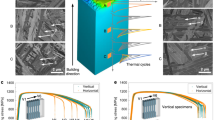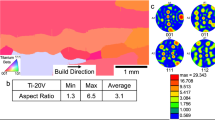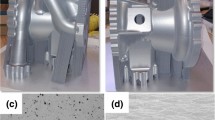Abstract
Calculation of Phase Diagram (CALPHAD) method was used to develop an additive manufacturing (AM) titanium alloy design strategy for new alloys in the Ti-Al-Fe system. This design strategy includes five key criteria addressing AM-processing suitability, mechanical properties, and heat treatment capability. The methods for evaluating the design criteria were determined considering both physical implications and computational efficiency. Available experimental results agree well with CALPHAD predictions in the design map. CALPHAD method in this work can be applied for high-throughput early-stage assessments in large composition space for new AM titanium alloy development.







Similar content being viewed by others
Notes
All composition units in this manuscript are %, mass fraction unless otherwise stated.
Certain commercial equipment, instruments, or materials are identified in this paper to foster understanding. Such identification does not imply recommendation or endorsement by the National Institute of Standards and Technology, nor does it imply that the materials or equipment identified are necessarily the best available for the purpose. The opinions, recommendations, findings, and conclusions in this publication do not necessarily reflect the views or policies of NIST or the United States Government.
References
Banerjee D, Williams JC (2013) Perspectives on titanium science and technology. Acta Mater 61(3):844–879. https://doi.org/10.1016/j.actamat.2012.10.043
Liu S, Shin YC (2019) Additive manufacturing of Ti6Al4V alloy: a review. Mater Des 164:107552. https://doi.org/10.1016/j.matdes.2018.107552
Lütjering G, Williams JC (2007) Titanium, 2nd edn. Springer, Berlin Heidelberg
Liang Z, Miao J, Brown T, Sachdev AK, Williams JC, Luo AA (2018) A low-cost and high-strength Ti-Al-Fe-based cast titanium alloy for structural applications. Scripta Mater 157:124–128. https://doi.org/10.1016/j.scriptamat.2018.08.005
Liang Z, Zhirnov I, Zhang F, Jones KK, Deisenroth D, Williams M, Kattner U, Moon K-W, Liu W-K, Lane B, Campbell C (2020) Development of computational framework for titanium alloy phase transformation prediction in laser powder-bed fusion additive manufacturing. Materialia 14:100934. https://doi.org/10.1016/j.mtla.2020.100934
Keller T, Lindwall G, Ghosh S, Ma L, Lane BM, Zhang F, Kattner UR, Lass EA, Heigel JC, Idell Y, Williams ME, Allen AJ, Guyer JE, Levine LE (2017) Application of finite element, phase-field, and CALPHAD-based methods to additive manufacturing of Ni-based superalloys. Acta Mater 139:244–253. https://doi.org/10.1016/j.actamat.2017.05.003
Koike M, Fujii H, Guo Q, Brezner M, Okabe T (2007) Evaluation of cast Ti-Al-Fe alloys for dental prostheses. Paper presented at the Ti-2007 Science and Technology, Kyoto, Japan
Aluminum alloys - mechanical properties (2008) https://www.engineeringtoolbox.com/properties-aluminum-pipe-d_1340.html. Accessed 25 Feb 2021
Nayer A (1997) The metals databook. McGraw-Hill, New York
Welsch G, Boyer R, Collings EW (1993) Materials properties handbook: titanium alloys. ASM International, USA
ThermoCalc (2021) TC-Python API programmer guide 2021a. https://www.thermocalc.com/support/documentation/. Accessed 19 Jan 2021
Borowy KH, Krammer KH (1985) On the properties of a new titanium alloy (Ti-5Al-2.5Fe) as implant material. In: Titanium ‘84: science and technology, vol 2, pp 1381–1386
Bania PJ, Hutt AJ, Adams RE, Parris WM (1992) Paper presented at the Titanium '92 Science and Technology, San Diego, California, USA
Fujii H, Takahashi K (2002) Development of high performance Ti-Fe-Al alloy series. Nippon Steel Tech Rep 85:113–117
Liang Z, Miao J, Sachdev AK, Williams JC, Luo AA (2020) Titanium alloy design and casting process development using an integrated computational materials engineering (ICME) approach. MATEC Web of Conf 321:10013
Author information
Authors and Affiliations
Corresponding author
Ethics declarations
Conflict of interest
On behalf of all authors, the corresponding author states that there is no conflict of interest.
Additional information
Publisher's Note
Springer Nature remains neutral with regard to jurisdictional claims in published maps and institutional affiliations.
Rights and permissions
About this article
Cite this article
Liang, Z., Kattner, U. & Campbell, C. Design Strategy for Additive Manufacturing Ti-Al-Fe Alloys with Calculation of Phase Diagram Method. Integr Mater Manuf Innov 10, 588–596 (2021). https://doi.org/10.1007/s40192-021-00237-0
Received:
Accepted:
Published:
Issue Date:
DOI: https://doi.org/10.1007/s40192-021-00237-0




